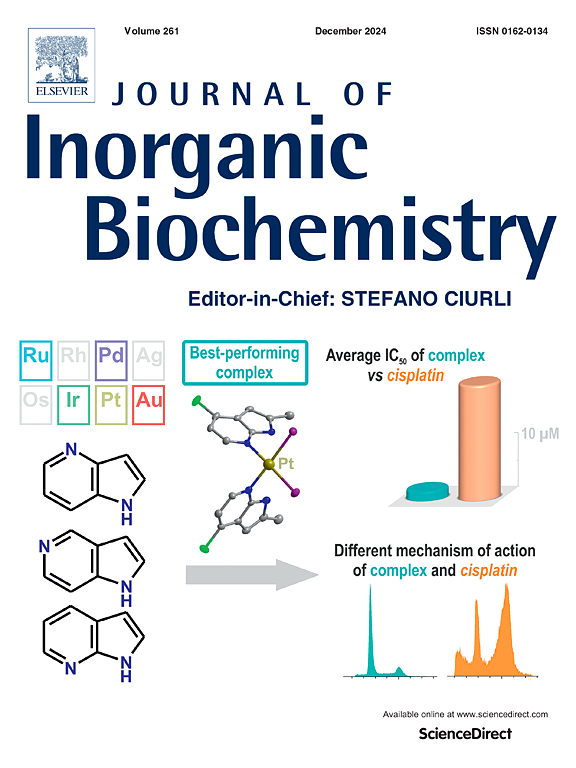Elucidating the metalation pathway of the Ec-1 metallothionein βE-domain: Insights into ZnII binding and protein folding
IF 3.8
2区 化学
Q2 BIOCHEMISTRY & MOLECULAR BIOLOGY
引用次数: 0
Abstract
Metallothioneins (MTs) are small cysteine-rich proteins that preferentially bind d10 metal ions such as ZnII, CuI, and CdII, playing essential roles in metal ion homeostasis and detoxification. The Ec-1 metallothionein from Triticum aestivum (common bread wheat) was the first plant metallothionein for which a 3D structure was successfully determined, although this structure represents only the fully metalated state of the protein. In this study, we aim to elucidate the metalation pathway of the βE-domain of wheat Ec-1. This domain features a mononuclear ZnII binding site composed of two cysteine and two highly conserved histidine residues, reminiscent of the Zn-finger motifs found in certain proteins. Moreover, the domain forms a trinuclear Zn3Cys9 cluster, similar to the β-cluster motif observed, for example, in vertebrate MTs. To investigate the metalation pathway of the βE-domain, we combined nuclear magnetic resonance (NMR) spectroscopy, mass spectrometry, and targeted cysteine modification techniques. Our results confidently identify the sequential binding site regions for each of the four ZnII ions and reveal intriguing, unexpected insights into the folding pathway of the peptide backbone.

阐明Ec-1金属硫蛋白β e结构域的金属化途径:对ZnII结合和蛋白质折叠的见解
金属硫蛋白(MTs)是一类富含半胱氨酸的小分子蛋白,可优先结合ni、CuI、CdII等10种金属离子,在金属离子稳态和解毒中起重要作用。来自小麦(普通面包小麦)的Ec-1金属硫蛋白是第一个成功确定三维结构的植物金属硫蛋白,尽管这种结构仅代表蛋白质的完全金属化状态。在本研究中,我们旨在阐明小麦Ec-1 β e结构域的金属化途径。该结构域具有由两个半胱氨酸和两个高度保守的组氨酸残基组成的单核ni结合位点,使人联想到某些蛋白质中发现的锌指基。此外,该结构域形成一个三核Zn3Cys9簇,类似于在脊椎动物MTs中观察到的β-簇基元。为了研究β e结构域的金属化途径,我们结合了核磁共振(NMR)光谱、质谱和靶向半胱氨酸修饰技术。我们的研究结果自信地确定了四种ni离子的顺序结合位点区域,并揭示了肽主链折叠途径的有趣的、意想不到的见解。
本文章由计算机程序翻译,如有差异,请以英文原文为准。
求助全文
约1分钟内获得全文
求助全文
来源期刊

Journal of Inorganic Biochemistry
生物-生化与分子生物学
CiteScore
7.00
自引率
10.30%
发文量
336
审稿时长
41 days
期刊介绍:
The Journal of Inorganic Biochemistry is an established international forum for research in all aspects of Biological Inorganic Chemistry. Original papers of a high scientific level are published in the form of Articles (full length papers), Short Communications, Focused Reviews and Bioinorganic Methods. Topics include: the chemistry, structure and function of metalloenzymes; the interaction of inorganic ions and molecules with proteins and nucleic acids; the synthesis and properties of coordination complexes of biological interest including both structural and functional model systems; the function of metal- containing systems in the regulation of gene expression; the role of metals in medicine; the application of spectroscopic methods to determine the structure of metallobiomolecules; the preparation and characterization of metal-based biomaterials; and related systems. The emphasis of the Journal is on the structure and mechanism of action of metallobiomolecules.
 求助内容:
求助内容: 应助结果提醒方式:
应助结果提醒方式:


